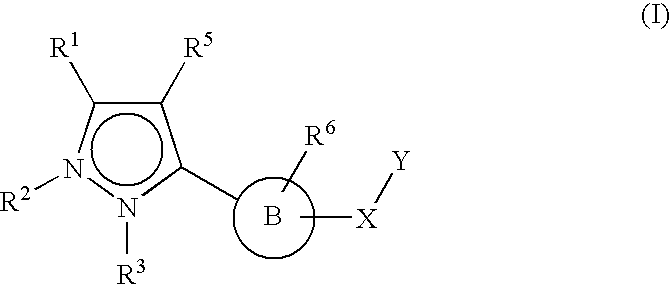Therapeutic compounds
a technology of compounds and active ingredients, applied in the field of therapeutic compounds, to achieve the effect of enhancing cognitive function
- Summary
- Abstract
- Description
- Claims
- Application Information
AI Technical Summary
Benefits of technology
Problems solved by technology
Method used
Image
Examples
example 1
Preparation of a Compound Wherein R1 is CF3, X is —C(═O)— and B is a Thiophene Ring
[0274]
[0275]A solution of the commercially available acid was mixed in DMF. To the solution were added EDC-HCl, HOBT hydrate, and Hunig's base to activate the acid; to the activated acid was added the desired amine to produce the final product. The reactions underwent standard aqueous work-up and the crude products were subsequently purified by normal phase, flash chromatography. The final products were confirmed for purity and identity by LC / MS.
example 2
Preparation of a Compound wherein R1 is CF3, X is —C(═O)— and B is a Phenyl Ring
[0276]
[0277]Oxalyl Chloride was added to 3-acetyl-benzoic acid (112) in dichloromethane below 20° C. After completion of the reaction, the mixture was concentrated to remove excess reagent. The residue was dissolved in fresh dichloromethane, cooled below 20° C., then followed by the addition of secondary amine and triethyl amine. The reaction stirred for 1 hour, was quenched with water, then washed with 5% HCl to remove excess triethyl amine. The organic layer was subsequently washed with 5% sodium bicarbonate to remove unreacted starting material, then washed with water, dried and concentrated to give 3-acetyl-N,N-dialkyl benzamide (113) in 75-80% yield.
[0278]Treatment of the 3-acetyl-benzamide 113 with a preformed solution of sodium ethyl methyl-ortho-trifluoroacetate, prepared by the mixture of NaOMe and ethyl trifluoroacetate in benzene, efficiently converted the material to diketo compound. Subseque...
example 3
Preparation of a Compound Wherein R1 is CF3, X is —C(═O)— and B is a Phenyl Ring
[0280]
[0281]Oxalyl Chloride was added to 4-acetyl-benzoic acid in dichloromethane and DMF below 20° C., and the reaction mass concentrated to remove excess reagent. The residue was dissolved in fresh dichloromethane and the secondary amine was then added. Still below 20° C., triethyl amine was added and stirred for an hour. The reaction was quenched with water, washed with 5% HCl to remove excess triethyl amine, and then washed with 5% sodium bicarbonate to remove unreacted starting material. The organic layer was washed with water, dried and concentrated to give 4-acetyl-dialkyl benzamide 116 in yields of 85-90%.
[0282]Treatment of the benzamide with pre-forming sodium ethyl methyl-ortho-trifluoroacetate from NaOMe and ethyl trifluoroacetate in benzene and reacting the preformed ortho-alkoxide with 4-acetyl-N,N-dialkyl benzamide and subsequent acidification followed by extraction gave compounds 117 in yi...
PUM
| Property | Measurement | Unit |
|---|---|---|
| pH | aaaaa | aaaaa |
| pH | aaaaa | aaaaa |
| temperature | aaaaa | aaaaa |
Abstract
Description
Claims
Application Information
 Login to View More
Login to View More - R&D
- Intellectual Property
- Life Sciences
- Materials
- Tech Scout
- Unparalleled Data Quality
- Higher Quality Content
- 60% Fewer Hallucinations
Browse by: Latest US Patents, China's latest patents, Technical Efficacy Thesaurus, Application Domain, Technology Topic, Popular Technical Reports.
© 2025 PatSnap. All rights reserved.Legal|Privacy policy|Modern Slavery Act Transparency Statement|Sitemap|About US| Contact US: help@patsnap.com



